Abstract
:1. Introduction
2. Materials and Methods
2.1. Study Area
2.2. Field Survey
2.3. Aerial and Satellite Imagery
2.4. Estimation of Height
2.5. Estimation of Crown Projection
2.6. Estimation of Cross-Sectional Area and Stem Volume
2.7. Extrapolation of Tree Attributes
2.8. Statistical Evaluation and Validation of Data
3. Results
3.1. General Evaluation of the Study Area
3.2. UAV Performance
3.3. UAV-Pléiades Extrapolation
4. Discussion
5. Conclusions
Acknowledgments
Author Contributions
Conflicts of Interest
References
- Järnstedt, J.; Pekkarinen, A.; Tuominen, S.; Ginzler, C.; Holopainen, M.; Viitala, R. Forest variable estimation using a high-resolution digital surface model. J. Photogramm. Remote Sens. 2012, 74, 78–84. [Google Scholar] [CrossRef]
- Straub, C.; Stepper, C.; Seitz, R.; Waser, L.T. Potential of UltraCamX stereo images for estimating timber volume and basal area at the plot level in mixed European forests. Can. J. For. Res. 2013, 43, 731–741. [Google Scholar] [CrossRef]
- White, J.C.; Wulder, M.A.; Vastaranta, M.; Coops, N.C.; Pitt, D.; Woods, M. The utility of image-based point clouds for forest inventory: A comparison with airborne laser scanning. Forests 2013, 4, 518–536. [Google Scholar] [CrossRef]
- Stepper, C.; Straub, C.; Pretzsch, H. Using semi-global matching point clouds to estimate growing stock at the plot and stand levels: Application for a broadleaf-dominated forest in central Europe. Can. J. For. Res. 2014, 45, 111–123. [Google Scholar] [CrossRef]
- Carleer, A.P.; Debeir, O.; Wolff, E. Assessment of Very High Spatial Resolution Satellite Image Segmentations. Photogramm. Eng. Remote Sens. 2005, 71, 1285–1294. [Google Scholar] [CrossRef]
- Edson, C.; Wing, M.G. Airborne Light Detection and Ranging (LiDAR) for Individual Tree Stem Location, Height, and Biomass Measurements. Remote Sens. 2011, 3, 2494–2528. [Google Scholar] [CrossRef] [Green Version]
- Popescu, S.C.; Wynne, R.H.; Nelson, R.F. Measuring Individual Tree Crown Diameter with Lidar and Assessing Its Influence on Estimating Forest Volume and Biomass. Can. J. For. Res. 2003, 29, 564–577. [Google Scholar] [CrossRef]
- Tomppo, E.; Olsson, H.; Ståhl, G.; Nilsson, M.; Hagner, O.; Katila, M. Combining national forest inventory field plots and remote sensing data for forest databases. Remote Sens. Environ. 2008, 112, 1982–1999. [Google Scholar] [CrossRef]
- McRoberts, R.E.; Cohen, W.B.; Næsset, E.; Stehman, S.V.; Tomppo, E.O. Using remotely sensed data to construct and assess forest attribute maps and related spatial products. Scand. J. For. Res. 2010, 25, 340–367. [Google Scholar] [CrossRef]
- Shao, Z.; Zhang, L. Estimating Forest Aboveground Biomass by Combining Optical and SAR Data: A Case Study in Genhe, Inner Mongolia, China. Sensors 2016, 16, 834. [Google Scholar] [CrossRef] [PubMed]
- Lehmann, J.R.K.; Nieberding, F.; Prinz, T.; Knoth, C. Analysis of Unmanned Aerial System-Based CIR Images in Forestry—A New Perspective to Monitor Pest Infestation Levels. Forests 2015, 6, 594–612. [Google Scholar] [CrossRef] [Green Version]
- Kayitakire, F.; Hamel, C.; Defourny, P. Retrieving forest structure variables based on image texture analysis and Ikonos-2 imagery. Remote Sens. Environ. 2006, 102, 390–401. [Google Scholar] [CrossRef]
- St-Onge, B.; Hu, Y.; Vega, C. Mapping the height and above-ground biomass of a mixed forest using LiDAR and stereo Ikonos images. Int. J. Remote Sens. 2008, 29, 1277–1294. [Google Scholar] [CrossRef]
- Ozdemir, I.; Karnieli, A. Predicting forest structural parameters using the image texture derived from worldview-2 multispectral imagery in a dryland forest, Israel. Int. J. Appl. Earth Obs. Geoinf. 2011, 13, 701–710. [Google Scholar] [CrossRef]
- Shamsoddini, A.; Trinder, J.C.; Turner, R. Pine plantation structure mapping usingWorldView-2 multispectral image. Int. J. Remote Sens. 2013, 34, 3986–4007. [Google Scholar] [CrossRef]
- Immitzer, M.; Stepper, C.; Böck, S.; Straub, C.; Atzberger, C. Forest ecology and management use of WorldView-2 stereo imagery and National Forest Inventory data for wall-to-wall mapping of growing stock. For. Ecol. Manag. 2016, 359, 232–246. [Google Scholar] [CrossRef]
- Astrium GEO-Information Services, Pléiades Imagery User Guide. Available online: http://www.cscrs.itu.edu.tr/assets/downloads/PleiadesUserGuide.pdf (accessed on 1 August 2012).
- Surový, P.; Ribeiro, N.A.; Pereira, J.S.; Yoshimoto, A. Estimation of Cork Production Using Aerial Imagery. Rev. Árvore 2015, 39, 853–861. [Google Scholar] [CrossRef]
- Pitkänen, J.; Maltamo, M.; Hyyppä, J.; Yu, X. Adaptive Methods for Individual Tree Detection on Airborne Laser Based Canopy Height Model. In Proceedings of ISPRS Working Group VIII/2: “Laser-Scanners for Forest and Landscape Assessment”; Theis, M., Koch, B., Spiecker, H., Weinacker, H., Eds.; University of Freiburg: Freiburg, Germany, 2004; pp. 187–191. [Google Scholar]
- Panagiotidis, D.; Abdollahnejad, A.; Surový, P.; Chiteculo, V. Determining tree height and crown diameter from high-resolution UAV imagery. Int. J. Remote Sens. 2016, 38, 1–19. [Google Scholar] [CrossRef]
- Wannasiri, W.; Nagai, M.; Honda, K.; Santitamont, P.; Miphokasap, P. Extraction of Mangrove Biophysical Parameters Using Airborne LiDAR. Remote Sens. 2013, 5, 1787–1808. [Google Scholar] [CrossRef]
- Tucker, C.J. Red and Photographic Infrared Linear Combinations for Monitoring Vegetation. Remote Sens. Environ. 1979, 8, 127–150. [Google Scholar] [CrossRef]
- Gitelson, A.; Stark, R.; Grits, U.; Rundquist, D.; Kaufman, Y.; Derry, D. Vegetation and Soil Lines in Visible Spectral Space: A Concept and Technique for Remote Estimation of Vegetation Fraction. Int. J. Remote Sens. 2002, 23, 2537–2562. [Google Scholar] [CrossRef]
- Arulbalaji, P.; Gurugnanam, B. Evaluating the Normalized Difference Vegetation Index Using Landsat Data by Envi in Salem District, Tamilnadu, India. Int. J. Dev. Res. 2014, 4, 1844–1846. [Google Scholar]
- Baltsavias, E.; Gruen, A.; Eisenbeiss, H.; Zhang, L.; Waser, L.T. High-Quality Image Matching and Automated Generation of 3D Tree Models. Int. J. Remote Sens. 2008, 29, 1243–1259. [Google Scholar] [CrossRef]
- Dandois, J.P.; Ellis, E.C. Remote Sensing of Vegetation Structure Using Computer Vision. Remote Sens. 2010, 2, 1157–1176. [Google Scholar] [CrossRef]
- Næsset, E. Predicting Forest Stand Characteristics with Airborne Scanning Laser Using a Practical Two-Stage Procedure and Field Data. Remote Sens. Environ. 2002, 80, 88–99. [Google Scholar] [CrossRef]
- Wang, L.; Gong, P.; Biging, G.S. Individual Tree-Crown Delineation and Treetop Detection in High-Spatial-Resolution Aerial Imagery. Photogramm. Eng. Remote Sens. 2004, 70, 351–357. [Google Scholar] [CrossRef]
- Jakubowski, M.K.; Li, W.; Guo, Q.; Kelly, M. Delineating Individual Trees from Lidar Data: A Comparison of Vector- and Raster-based Segmentation Approaches. Remote Sens. 2013, 5, 4163–4186. [Google Scholar] [CrossRef]
- Tuominen, S.; Balazs, A.; Saari, H.; Pölönen, I.; Sarkeala, J.; Viitala, R. Unmanned aerial system imagery and photogrammetric canopy height data in area-based estimation of forest variables. Silva Fenn. 2015, 49, 1348. [Google Scholar] [CrossRef]
- Wallner, A.; Elatawneh, A.; Schneider, T.; Knoke, T. Estimation of forest structural information using rapideye satellite data. Forestry 2015, 88, 96–107. [Google Scholar] [CrossRef]
- Straub, C.; Weinacker, H.; Koch, B. A comparison of different methods for forest resource estimation using information from airborne laser scanning and CIR orthophotos. Eur. J. For. Res. 2010, 129, 1069–1080. [Google Scholar] [CrossRef]
- Heiskanen, J. Estimating aboveground tree biomass and leaf area index in a mountain birch forest using ASTER satellite data. Int. J. Remote Sens. 2006, 27, 1135–1158. [Google Scholar] [CrossRef]


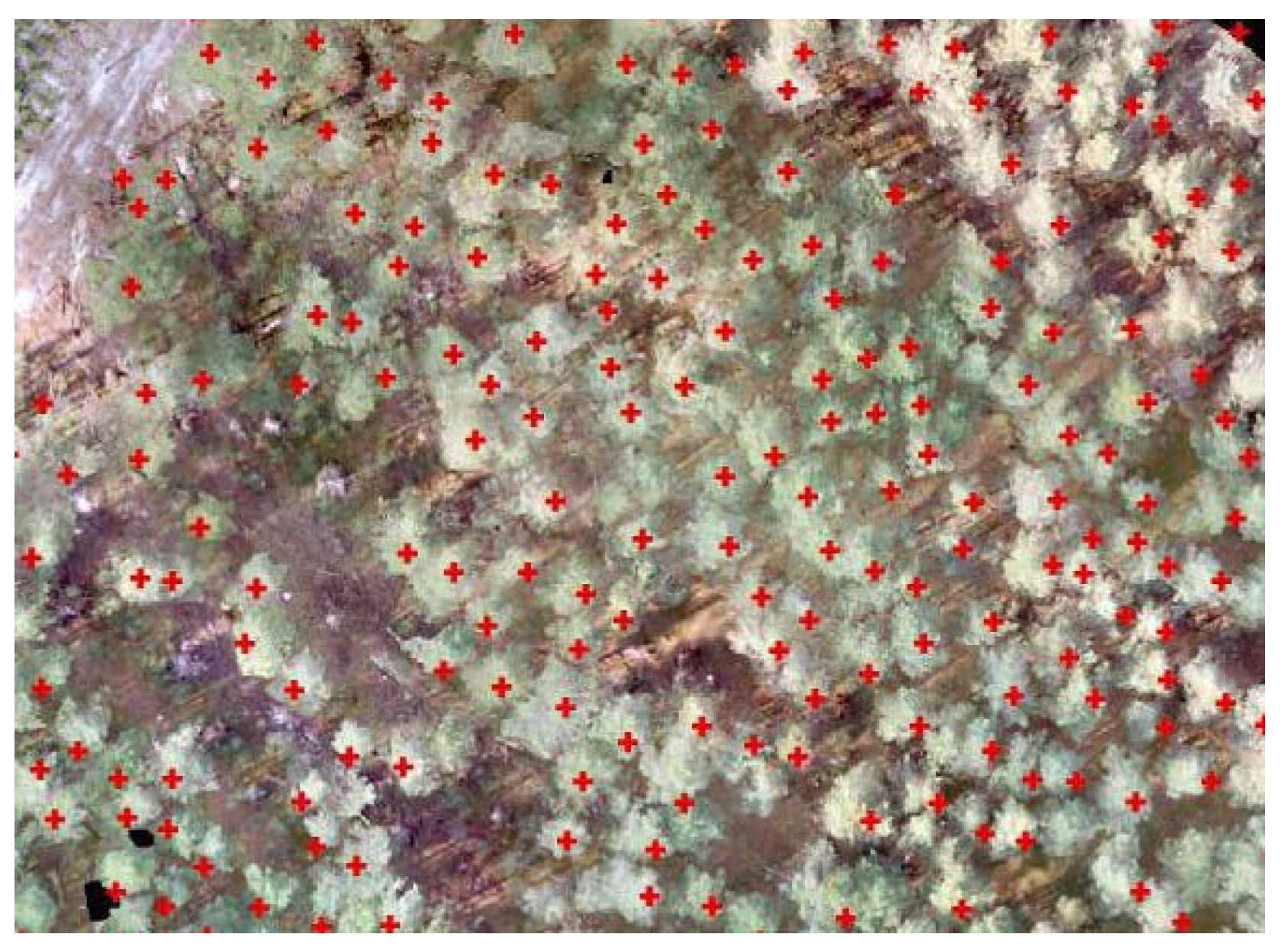


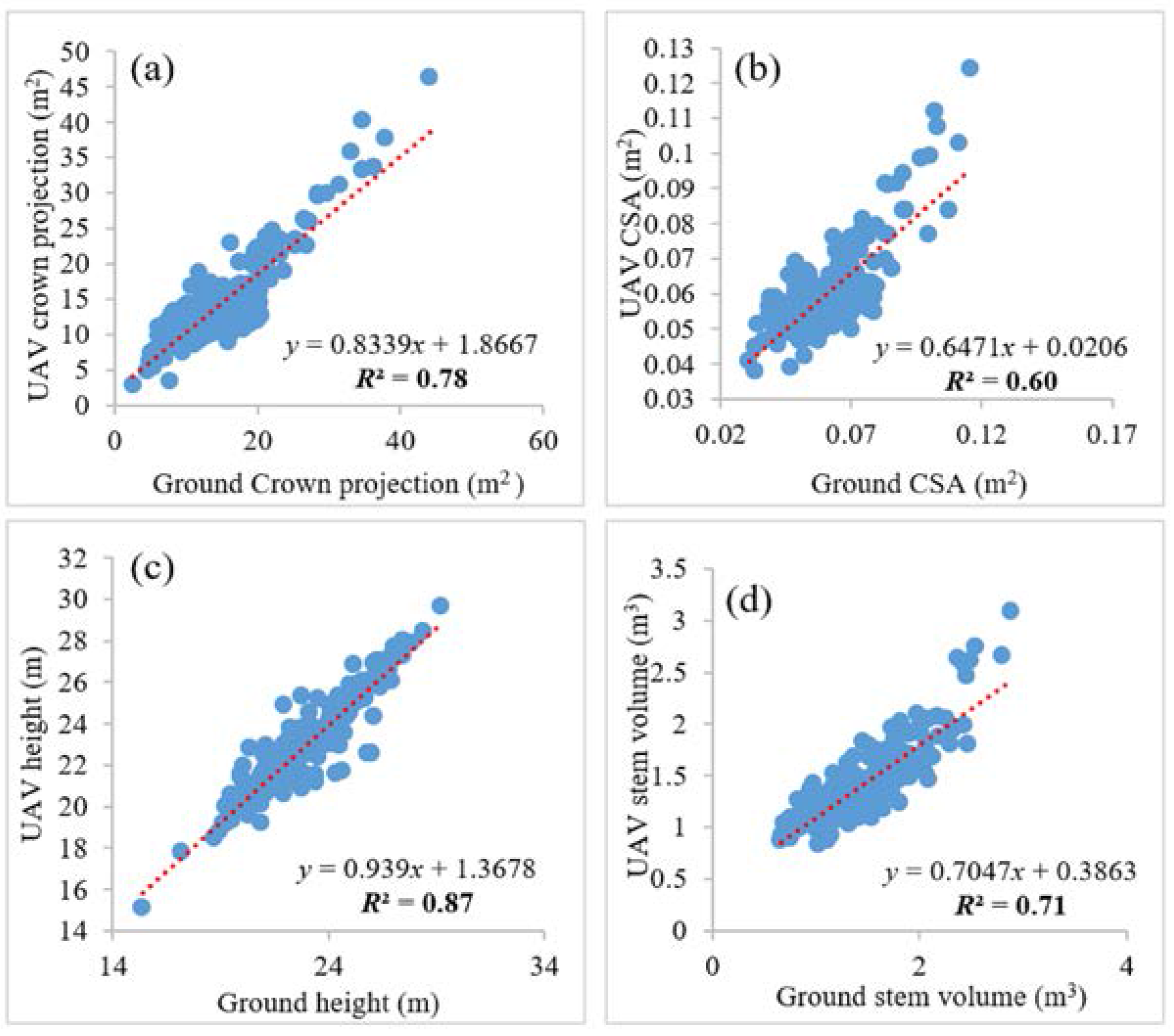
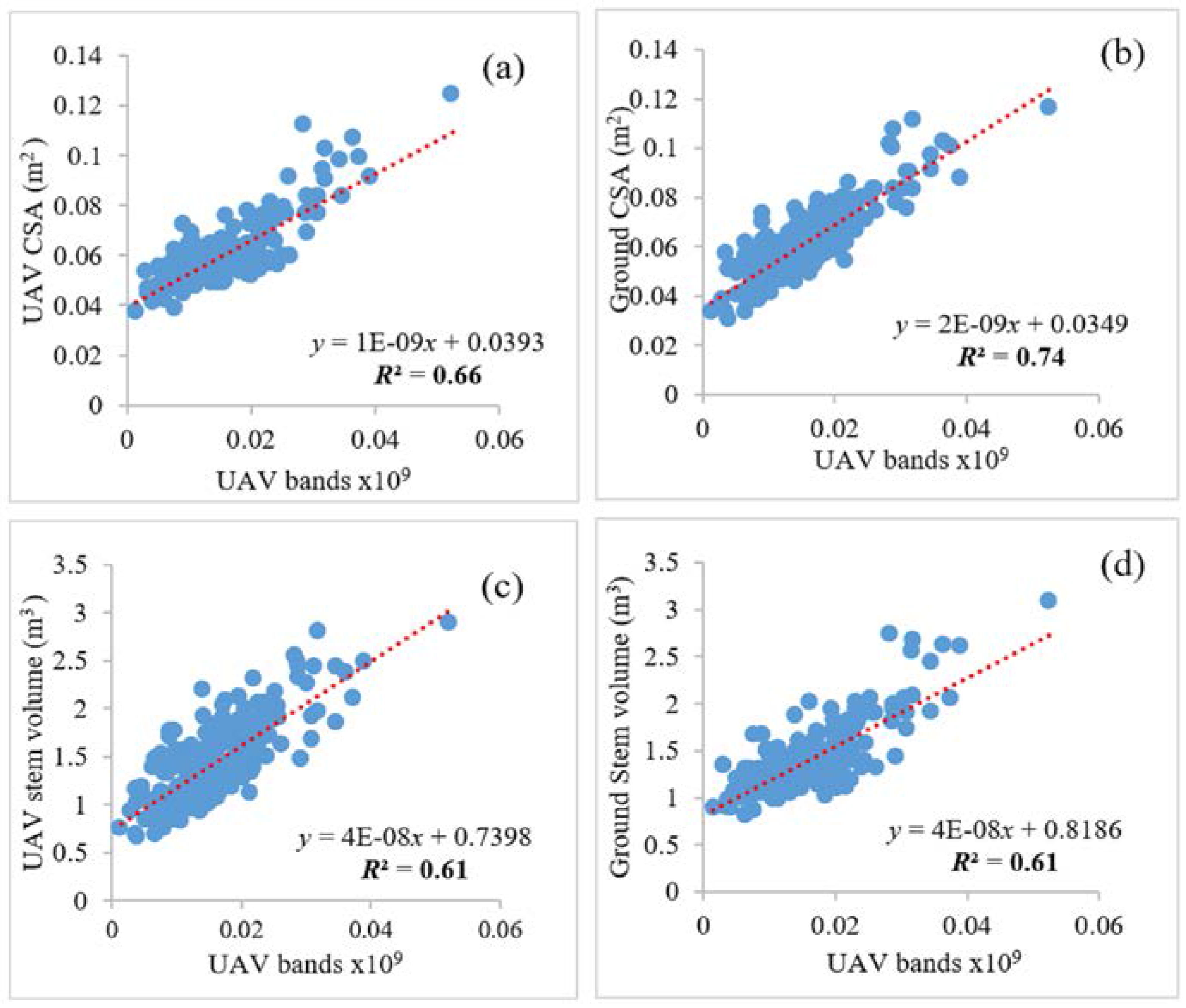
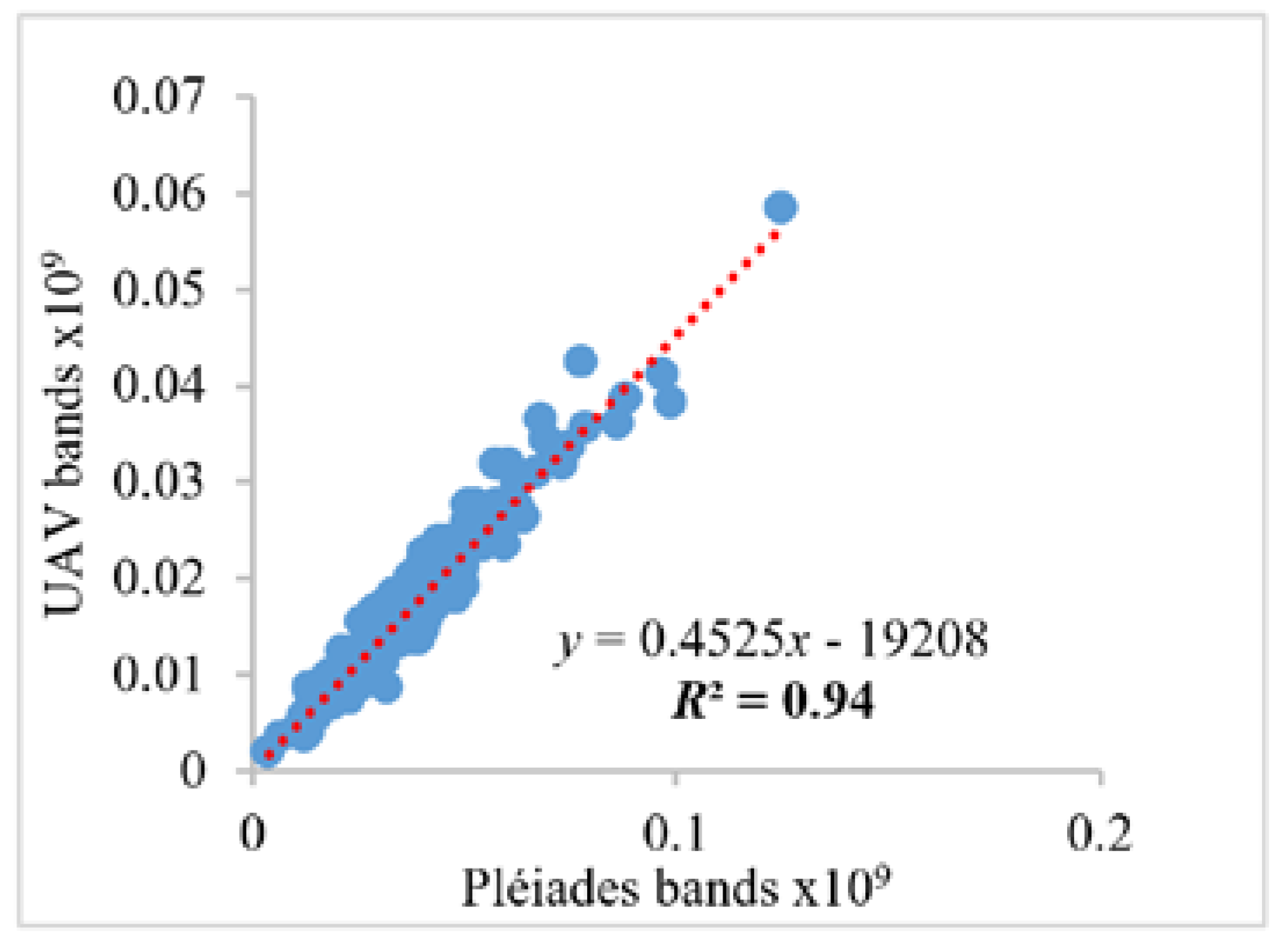
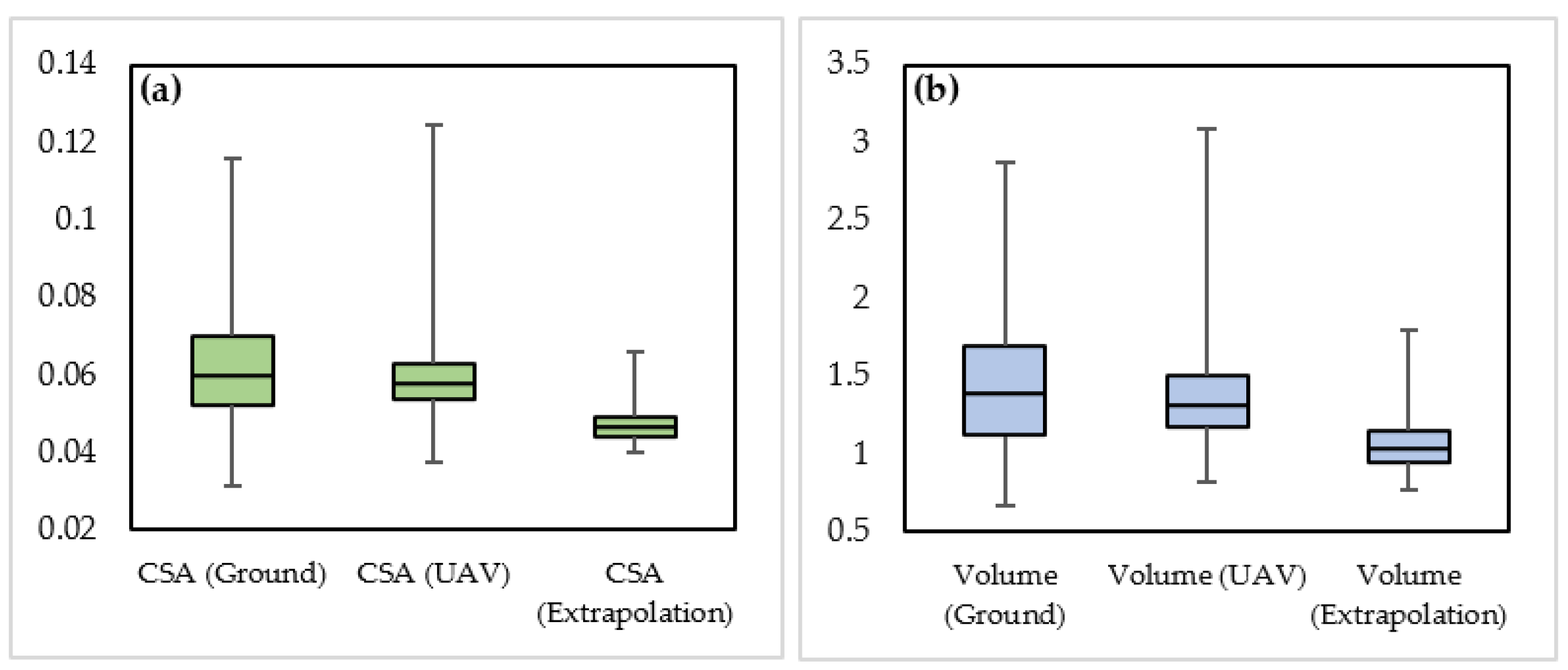
| Imagery Products | Panchromatic: 50-cm resolution, black and white |
| 2-m multispectral (RGB—red, green, blue) | |
| Bundle: 50-cm black and white and 2-m multispectral | |
| Spectral Bands | Panchromatic: 480–830 nm |
| Blue: 430–550 nm | |
| Green: 490–610 nm | |
| Red: 600–720 nm | |
| Near Infrared: 750–950 nm | |
| Image Location Accuracy | With ground control points: 1 m |
| Without ground control points: 3 m (CE90) |
| Sample | Index | Crown Projection (m2) | DBH (m) | CSA (m2) | Height (m) | Volume (m3) |
|---|---|---|---|---|---|---|
| Plot 1 N = 74 | Mean | 15.24 | 0.28 | 0.06 | 21.23 | 1.30 |
| Variability | 30.61 | 0.15 | 0.06 | 7.00 | 1.30 | |
| Std. | 5.20 | 0.03 | 0.01 | 1.33 | 0.30 | |
| Plot 2 N = 72 | Mean | 14.71 | 0.28 | 0.06 | 23.03 | 1.43 |
| Variability | 41.54 | 0.17 | 0.08 | 13.80 | 2.10 | |
| Std. | 7.75 | 0.04 | 0.02 | 2.24 | 0.46 | |
| Plot 3 N = 77 | Mean | 14.94 | 0.28 | 0.06 | 24.49 | 1.56 |
| Variability | 28.67 | 0.17 | 0.08 | 8.20 | 2.13 | |
| Std. | 6.45 | 0.03 | 0.02 | 2.00 | 0.45 | |
| Total N = 223 | Mean | 14.97 | 0.28 | 0.06 | 22.96 | 1.43 |
| Variability | 41.54 | 0.18 | 0.08 | 13.80 | 2.21 | |
| Std. | 6.51 | 0.03 | 0.01 | 2.32 | 0.42 |
| ID | N | RMSE | RMSE% | Bias | Bias % | df | p-Value |
|---|---|---|---|---|---|---|---|
| 1 | 223 | 0.0069 | 11.35 | 0.0018 | 2.96 | 222 | 0.00 |
| 2 | 223 | 3.14 | 20.96 | - | - | 222 | 0.00 |
| 3 | 223 | 0.01 | 15.24 | - | - | 222 | 0.00 |
| 4 | 223 | 0.86 | 3.73 | - | - | 222 | 0.00 |
| 5 | 223 | 0.23 | 15.88 | - | - | 222 | 0.00 |
| Tree Parameter | Min | Max | Mean | Std. | Sum | Median |
|---|---|---|---|---|---|---|
| CSA (Ground) | −0.208 ** | 0.133 * | 0.224 ** | 0.160 * | 0.864 ** | 0.229 ** |
| Stem volume (Ground) | −0.200 ** | 0.131 | 0.239 ** | 0.180 ** | 0.795 ** | 0.255 ** |
| CSA (UAV) | −0.140 * | 0.0641 | 0.055 | 0.012 | 0.821 ** | 0.049 |
| Stem volume (UAV) | −0.158 * | 0.072 | 0.107 | 0.05 | 0.795 ** | 0.115 |
| Vegetation Index | CSA (Ground) | Stem Volume (Ground) | CSA (UAV) | Stem Volume (UAV) |
|---|---|---|---|---|
| VI | 0.103 | 0.208 ** | 0.110 | 0.218 ** |
| GRVI | −0.106 | −0.210 ** | −0.113 | −0.221 ** |
| VARI g | −0.106 | −0.211 ** | −0.112 | −0.221 ** |
| Index | CSA | Volume |
|---|---|---|
| RMSE | 0.018 | 0.21 |
| RMSE% | 30.56 | 31.01 |
| Bias | −0.015 | −0.39 |
© 2018 by the authors. Licensee MDPI, Basel, Switzerland. This article is an open access article distributed under the terms and conditions of the Creative Commons Attribution (CC BY) license (http://creativecommons.org/licenses/by/4.0/).
Share and Cite
Abdollahnejad, A.; Panagiotidis, D.; Surový, P. Estimation and Extrapolation of Tree Parameters Using Spectral Correlation between UAV and Pléiades Data. Forests 2018, 9, 85. https://doi.org/10.3390/f9020085
Abdollahnejad A, Panagiotidis D, Surový P. Estimation and Extrapolation of Tree Parameters Using Spectral Correlation between UAV and Pléiades Data. Forests. 2018; 9(2):85. https://doi.org/10.3390/f9020085
Chicago/Turabian StyleAbdollahnejad, Azadeh, Dimitrios Panagiotidis, and Peter Surový. 2018. "Estimation and Extrapolation of Tree Parameters Using Spectral Correlation between UAV and Pléiades Data" Forests 9, no. 2: 85. https://doi.org/10.3390/f9020085







